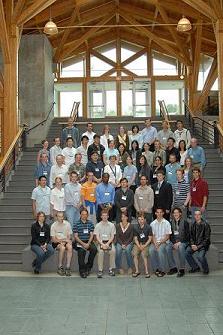RiboWest
A network of scientists with an interest in RNA research in Western Canada
Navigation |
RiboWest2007 in Prince GeorgeGroup picture Keynote speakerAdrian Ferré-d'Amaré, Hutchinson Center Title: Adrian R. Ferré-D'Amaré Fred Hutchinson Cancer Research Center Compared to proteins, RNA has reduced chemical diversity. Nonetheless, cells employ riboswitches for selective binding to small-molecule metabolites and ribozymes for biochemical catalysis. We will discuss studies on two sequence specific endonuclease RNAs: the hairpin ribozyme and the glmS ribozyme-riboswitch. Crystallographic structure determinations of the hairpin ribozyme in the transition state as well as in its precursor and product-bound forms revealed that this RNA assembles into a remarkably rigid active state that can preferentially hydrogen bond to the transition state. The hairpin ribozyme does not employ divalent cations or nucleobases with perturbed acidity for catalysis. Thus, most of the million-fold rate enhancement it achieves must come from proximity effects and transition state binding. Preferential binding to the transition state, a catalytic strategy first postulated by Pauling in 1946 for protein enzymes, is a particularly attractive catalytic strategy for RNA enzymes, which lack chemically versatile side chains, but are proficient in hydrogen bonding. The glmS ribozyme-riboswitch is a gene-regulatory RNA that lies in the 5' non-coding region of the mRNA that encodes glucoasamine-6-phosphate synthetase in many Gram-positive bacteria. It has a latent self-cleaving activity that is uncovered by binding to glucosamine-6-phosphae (GlcN6P). Crystallographic analysis demonstrated that the glmS ribozyme-riboswitch is not an allosteric enzyme. Rather, upon binding to its rigid, solvent-exposed binding site, GlcN6P completes the active site of the RNA, thereby serving as a true coenzyme. The demonstration that this RNA can harness the chemical diversity of a small molecule to achieve catalysis suggests that other uncharacterized coenzyme-dependent ribozymes lurk in the biosphere. Our structural demonstration that RNAs can assemble into remarkably rigid folds suggests that a reason for the persistence of RNA in large macromolecular assemblies is that its rigidity makes it uniquely suited for mechanically coupling distant parts of molecular machines. |
Past Meetings |
